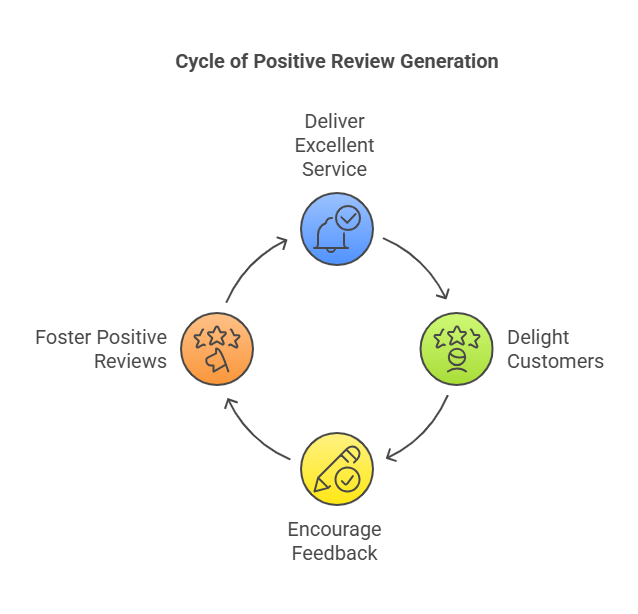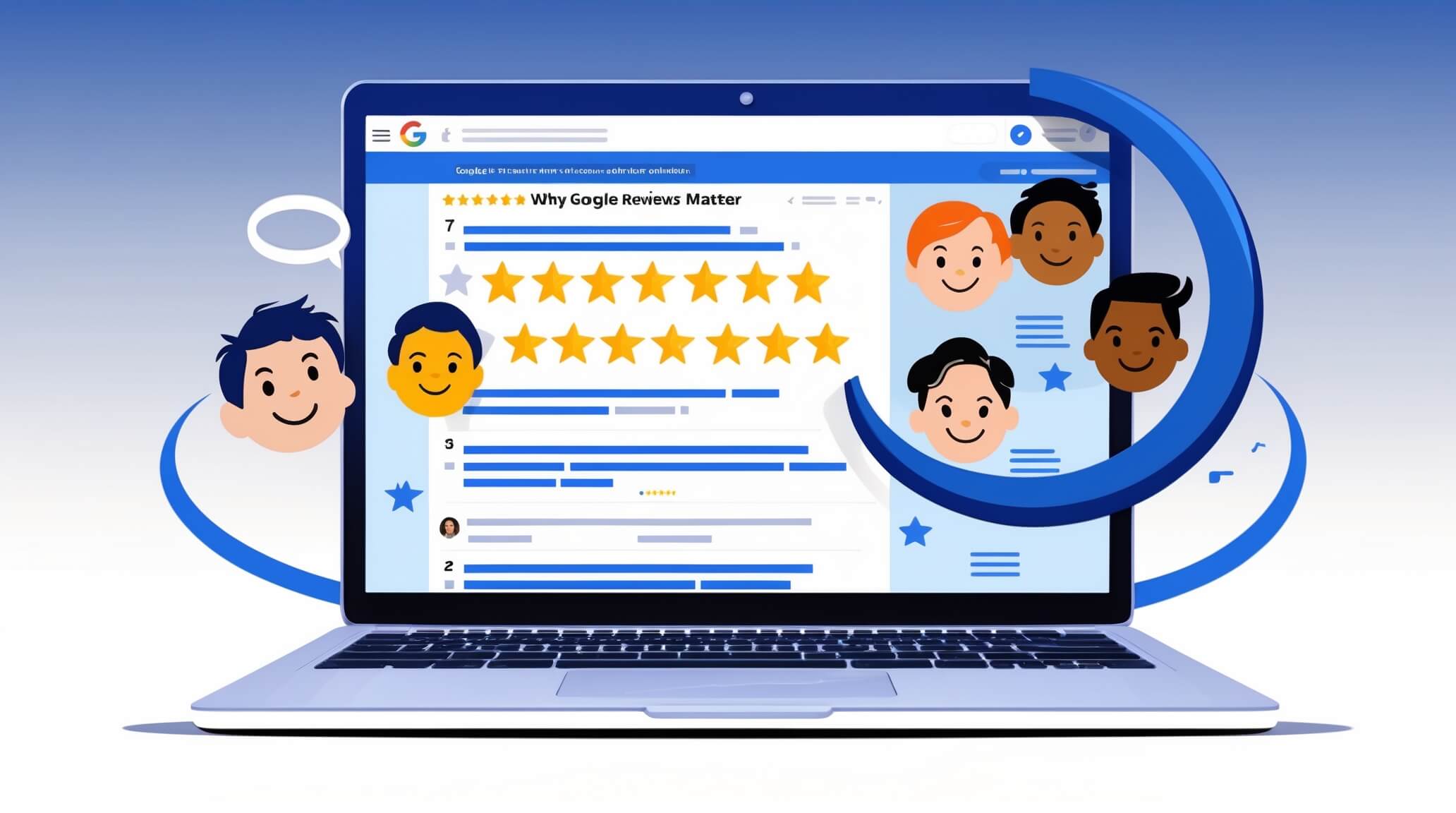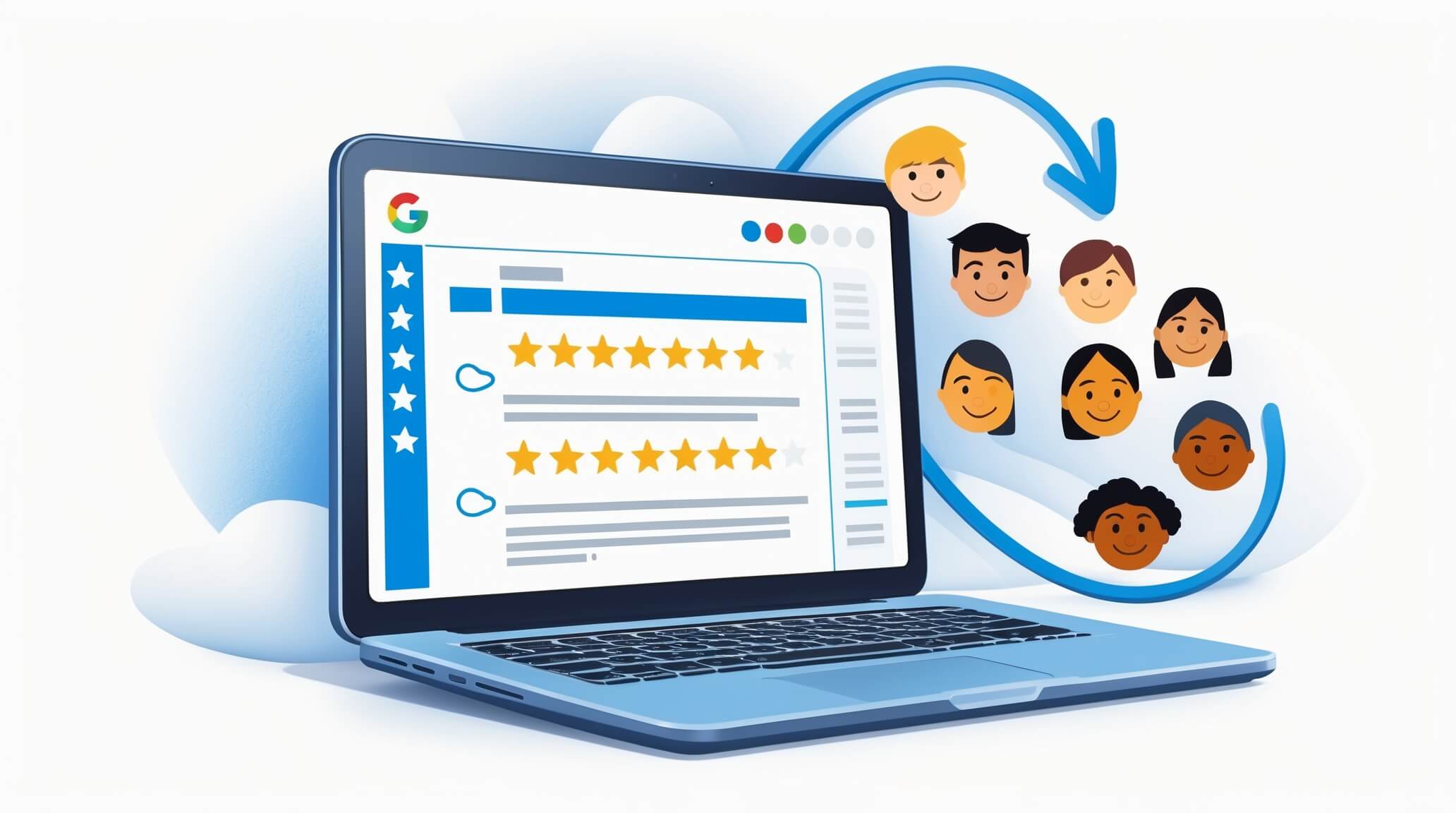
Why Google Reviews Matter: Building Trust and Credibility Online
Table of Contents
In an era where information is just a click away, online reviews wield tremendous power over how potential customers perceive a brand. Among the many platforms for user feedback, Google Reviews stands out as a major influencer—particularly as it ties directly into Google Search and Google Maps results. In 2025, studies indicate that over 90% of consumers check online reviews before deciding on a local business or service, and Google Reviews often top the list of places they look.
For companies aiming to boost their credibility, investing time and resources into managing Google Reviews can provide a significant competitive advantage. Not only do positive testimonials showcase authenticity, but the quantity, quality, and recency of reviews can also impact local search rankings. Moreover, prospective customers who see a well-maintained Google My Business profile with regular feedback are more likely to trust that brand, translating to increased conversions and stronger community ties.
In this article, we explore why Google Reviews matter, how they shape user decisions, and practical steps to foster more positive feedback while dealing constructively with any negatives. If you’re looking to upgrade your approach to customer service and brand reputation, read on.
“Online reviews are the digital equivalent of word-of-mouth. A few glowing sentences on Google can sway new customers before they ever speak to you directly,” says Ciaran Connolly, Director of ProfileTree.
The Influence of Google Reviews in 2025
Google Reviews have evolved into a critical currency of trust, shaping consumer decisions through instant, peer-driven feedback. As technology accelerates and online competition intensifies, a well-curated stream of reviews can elevate a business’s reputation, sway potential customers, and even influence search engine visibility.
In 2025, these digital endorsements carry even more weight, forging credibility and fostering transparency in an increasingly interconnected marketplace. Understanding the influence of Google Reviews sets the foundation for why they are critical. Now, let’s explore how these reviews first catch the eye of potential customers and shape their initial impressions of your business.
Shaping First Impressions
When someone searches for a local restaurant, a marketing agency, or a nearby hotel, Google’s local pack often displays the business name, star rating, and review count—front and centre. That “at-a-glance” star rating can persuade a user to click your business listing over a competitor’s.
Consumers typically see anything above 4.0 stars as trustworthy. Going further, some user surveys show that a 4.5+ rating is almost essential to appear in the top cluster of choices when users are strapped for time.
Furthermore, the search result snippet often includes a short text excerpt from a recent review. If the excerpt highlights quality, prompt service, or an amazing experience, it immediately builds credibility and nudges the user to learn more.
First impressions matter, but they are just the beginning. The next step involves understanding how these impressions translate into higher visibility through local SEO and ranking signals, which are heavily influenced by the quality of your Google Reviews.
Local SEO and Ranking Signals
Google’s algorithms factor in review signals—like average rating, number of reviews, and frequency of new feedback—to determine local search relevance. While the exact weighting remains secret, SEO professionals generally agree that strong reviews correlate with higher local map positions.
This synergy between reviews and local SEO is especially critical for brick-and-mortar shops, service providers, or area-based professionals like lawyers, plumbers, and web design agencies.
Moreover, 2025 data from various SEO tools suggests that listings with +30 genuine reviews typically outrank those with only a handful, given other ranking factors (like proximity and category) are similar. It underscores why actively encouraging satisfied customers to leave reviews is both a marketing and an SEO strategy.
While enhancing your SEO is crucial, the credibility that comes from high-quality reviews provides the social proof that consumers seek. This trust is built when customers see consistent, positive feedback, which influences their decision-making process.
Credibility and Social Proof
Consumers trust reviews because they come from real people. Even if some reviews might be biased, the sheer volume of feedback helps paint a more objective picture.
A recent study found that 78% of users treat Google Reviews similarly to recommendations from friends, reflecting the power of social proof. Brands lacking reviews or with older, stale feedback seem out of date or unresponsive, turning potential customers away.
Encouraging More Positive Google Reviews

It’s essential to actively encourage more positive reviews. Let’s delve into practical strategies to not only increase the quantity of your reviews but also ensure their quality reflects well on your brand.
Providing a Stellar Customer Experience First
The best way to garner positive reviews is to deliver excellent service or high-quality products consistently. If customers feel delighted by your brand, they’re more receptive to leaving feedback when asked.
Ensuring staff friendliness, quick problem resolution, and thorough follow-ups creates a ripple effect where customers feel they want to express their thanks publicly.
Making It Easy to Leave Feedback
While many customers rely on Google Reviews organically, a large chunk might forget or not know how to post their thoughts. Streamline the process:
- Direct Links: Generate a short link that leads directly to your Google My Business “Leave a Review” box. Place it in follow-up emails or text messages post-purchase.
- QR Codes: In-store or on receipts, display a QR code that redirects users to your Google review page, prompting them on the spot.
- Automated Reminders: If you have a CRM, set up an automated email a few days after service completion, politely asking for a review. Provide direct instructions or a link.
Timing and Personalisation
Catching customers at the right moment—often right after a successful transaction or when they express satisfaction via email—boosts the chances of a positive review. Additionally, personalising the request (e.g., referencing the product they bought or the service outcome) conveys authenticity.
Rather than a generic “Please review us,” try a message like: “We’re thrilled you enjoyed [X service]. Would you mind sharing your thoughts on Google so others can benefit from your experience?”
Incentives vs. Ethics
In some regions, offering incentives in exchange for reviews contravenes guidelines, especially if they’re financial or promise freebies. Always check Google’s policies and local laws.
You can gently encourage feedback through courtesy or emotional appeals (like emphasising how reviews help small businesses grow). Avoid crossing the line into bribery, as it may risk authenticity or even lead to penalty flags from Google.
Strategies for Managing Negative Google Reviews

Even with proactive efforts to garner positive reviews, encountering some negative feedback is inevitable. The key to maintaining your reputation lies in how effectively you handle these criticisms. Here’s how to turn potential negatives into opportunities for demonstrating your commitment to customer satisfaction.
The Realities of Negative Reviews
No matter how impeccable your service is, occasional negative feedback might happen—due to misunderstandings, external factors, or honest mistakes. How you respond can either salvage a relationship or exacerbate the issue.
In 2025, brands are under even more scrutiny: ignoring a negative review is seen as irresponsible, while an empathic, solution-oriented reply can demonstrate accountability.
Responding Tactfully and Swiftly
- Stay Calm and Professional: Start by acknowledging the reviewer’s experience. Even if you disagree, remain courteous.
- Apologise Where Appropriate: If there’s any fault on your side, own it. A genuine apology can defuse tensions.
- Propose a Resolution: Offer to fix the issue, whether by redoing a service, providing a partial refund, or giving a direct communication channel to address the problem offline.
- Move Detailed Discussions Offline: Provide a phone number or email for direct resolution. This keeps the public thread concise yet shows you’re proactive.
A measured, helpful reply can turn a disgruntled critic into a loyal advocate, and it signals to others reading your reviews that the brand cares.
Learning from Criticism
Sometimes, negative reviews point to genuine operational flaws. Over time, if you see recurring themes—like slow shipping, subpar phone support, or unexpected charges—take them as constructive feedback. Implement improvements, then in future promotional materials or blog posts, highlight how you’ve listened and evolved. This willingness to improve fosters trust.
Expert Note: “Responding elegantly to negative feedback is part of modern customer service. The occasional critical review won’t ruin your reputation—but ignoring it or reacting poorly might,” emphasises Ciaran Connolly.
Leveraging Google Reviews for Growth

Effectively managing negative feedback is part of a broader strategy to leverage Google Reviews for business growth. Let’s explore how to use both positive and negative reviews to your advantage, enhancing your service offerings and customer engagement.
Showcasing Reviews on Your Website
Adding a reviews widget or curated testimonial snippets can enrich your site’s credibility. Plugins exist that embed your Google review feed, automatically updating with fresh feedback.
This synergy further cements the authenticity of your brand claims. If a prospective client visits your site and sees consistent 5-star remarks, it reassures them that these are verifiable, external endorsements—much stronger than self-proclaimed accolades.
Social Media Amplification
Share standout quotes or star ratings on LinkedIn, Facebook, Twitter (X), or Instagram. This cross-pollinates your positive feedback to a broader audience, encouraging followers to read or leave their own reviews.
Link back to your Google listing, reminding fans how simple it is to rate or comment. Celebrating your best reviewers (e.g., a monthly “review spotlight” post) not only expresses gratitude but also entices others to chip in.
Incorporating Reviews into Offline Marketing
For certain businesses, offline materials (like brochures or physical adverts) might also benefit from a short excerpt highlighting, “Rated 4.8★ on Google with +100 reviews.” This quick snippet can speak volumes about reliability, bridging the gap between digital reputation and real-world brand presence.
Integrating AI and Automation for Review Management
In 2025, AI solutions have matured to the point of offering automated sentiment analysis, review monitoring, and even suggested responses. Implementing these tools can streamline your approach to Google Reviews:
- Sentiment Analysis: AI scans fresh reviews, classifying them as positive, neutral, or negative. This helps your support team prioritise urgent negative feedback, ensuring swift, thoughtful responses.
- Auto-Generated Response Suggestions: Some platforms propose response templates based on the review’s content. Staff can then customise them for a personal touch, speeding up the process without losing authenticity.
- Trend Spotting: By analysing themes in reviews over time (e.g., “delivery,” “support line,” “pricing”), AI highlights recurring topics—both good and bad—empowering data-driven improvements.
- Scheduled Follow-Ups: AI-based CRM systems can automatically prompt customers for a review after certain triggers (like successful project completion or 7 days post-purchase).
While these tools enhance efficiency, be sure to keep a human oversight element. Automated or robotic-sounding replies can alienate customers if the personal factor is lost.
Overcoming Common Challenges

As you implement these strategies, you’ll likely face challenges along the way. Let’s address some of the most common hurdles businesses encounter with Google Reviews and discuss solutions to overcome them, ensuring your review management process is as smooth as possible.
Fear of Asking
Many businesses shy away from explicitly requesting reviews, worried it may bother clients. However, polite, contextually timed invitations are rarely viewed negatively—especially if the customer genuinely had a positive experience. Transparent, honest appeals often yield remarkable compliance.
Managing Fake or Malicious Reviews
From disgruntled ex-employees to unscrupulous competitors, fake reviews occasionally appear. Google does allow you to flag suspicious reviews; Provide evidence (e.g., no record of a transaction) to support your claim. While Google’s removal process can be slow, persistent efforts and screenshots can help. In the meantime, publicly respond politely, noting you can’t identify them as a genuine customer, which signals caution to readers.
Handling Large Volumes
Established brands may receive dozens of reviews daily. A robust system—possibly aided by AI filtering or a dedicated staff member—ensures no feedback slips through the cracks. Even if you can’t provide detailed responses to every single positive note, a brief “Thank you!” helps maintain engagement.
Projecting Your Future Reputation Goals
Once you’ve navigated these challenges, it’s time to look ahead. Projecting and achieving your future reputation goals requires a strategic approach to continuously leveraging customer feedback. Here’s how to set and reach these targets, ensuring your business’ lasting success.
Setting Targets for Review Quality and Quantity
Define KPIs like:
- Achieve a 4.5+ rating within six months,
- Gather X new reviews each month, or
- Maintain a response rate of 100% (even if just a short thank-you).
Tracking these metrics fosters accountability, giving your team tangible goals. Update progress periodically in team meetings or newsletters.
Aligning with Holistic Customer Service
Google Reviews cannot be divorced from overall service quality. If you want consistent, glowing feedback, ensure each department aligns with a customer-centric ethos.
Train staff on soft skills, helpfulness, and proactiveness. Investing in digital or AI upgrades for chat support or knowledge bases further reduces friction points that might lead to negative feedback.
Adapting to 2025 and Beyond
As Google evolves (integrating more AI-based features in search results or shifting how star ratings display on mobile), businesses must remain agile. Keep an eye on Google My Business updates—like new Q&A sections, short video reviews, or local guide enhancements. Early adopters of new features typically enjoy a spike in visibility and user engagement.
“Embracing Google’s new review tools and AI-driven insights can future-proof your brand’s credibility. The end goal is simple: turn happy customers into digital advocates,” reiterates Ciaran Connolly.
Final Thoughts: Strengthening Trust Through Google Reviews
Google Reviews, more than any other single platform, has the power to influence local customer decision-making—often at the point they’re ready to buy. Nurturing this channel by delivering outstanding service, politely requesting feedback, and swiftly addressing concerns can anchor your brand as reliable and transparent.
Remember that negative reviews are not doomsday scenarios but opportunities to display your commitment to resolution, often winning over sceptics.
To summarise:
- Deliver excellent experiences and ask for reviews.
- Provide direct, user-friendly links or QR codes.
- Respond professionally to negatives, gleaning lessons.
- Use AI-based monitoring for insights and efficiency.
- Integrate reviews into digital marketing—on your website and social platforms.
That cycle—great experience → positive review → brand growth → refined service—forms a self-sustaining loop of continual improvement. Start focusing on your Google Reviews today, and watch your trust factor, conversions, and local rankings rise in tandem.
FAQs: Google Reviews Management in 2025
How often should I check my Google Reviews?
It’s advisable to monitor your Google Reviews at least once a week. For businesses with higher volumes of customer interactions, daily checks may be necessary to respond promptly and manage feedback effectively.
Can Google Reviews impact my business beyond SEO?
Yes, beyond improving SEO, Google Reviews can significantly influence consumer trust and decision-making. They also play a crucial role in the overall customer experience, providing insights into what customers appreciate and what areas need improvement.
What is the best way to solicit Google Reviews without seeming pushy?
The best approach is to integrate the request into your follow-up communication. A simple message after a purchase or service, expressing hope that the customer is satisfied and kindly asking for feedback if they are, tends to be well-received. Make sure the process is as easy as possible by including a direct link to your review page.
How can I handle fake reviews that seem to damage my business’s reputation?
If you suspect a review is fake, you can report it to Google for investigation. Ensure you provide any evidence that supports your claim. Always maintain professionalism in your public responses, acknowledging the review but noting politely that you do not have any record of their experience as described.
What metrics should I track to measure the success of my Google Reviews strategy?
Key metrics to track include the number of reviews, average star rating, response time to reviews, and the sentiment of feedback. Monitoring these metrics can help you gauge customer satisfaction and identify areas for improvement.
How should I train my team to handle Google Reviews effectively?
Educate your team on the importance of customer feedback and train them on how to respond professionally to both positive and negative reviews. Role-playing scenarios can be useful for preparing your team to handle tricky situations. Additionally, make sure they understand the tools and processes in place for managing reviews.




